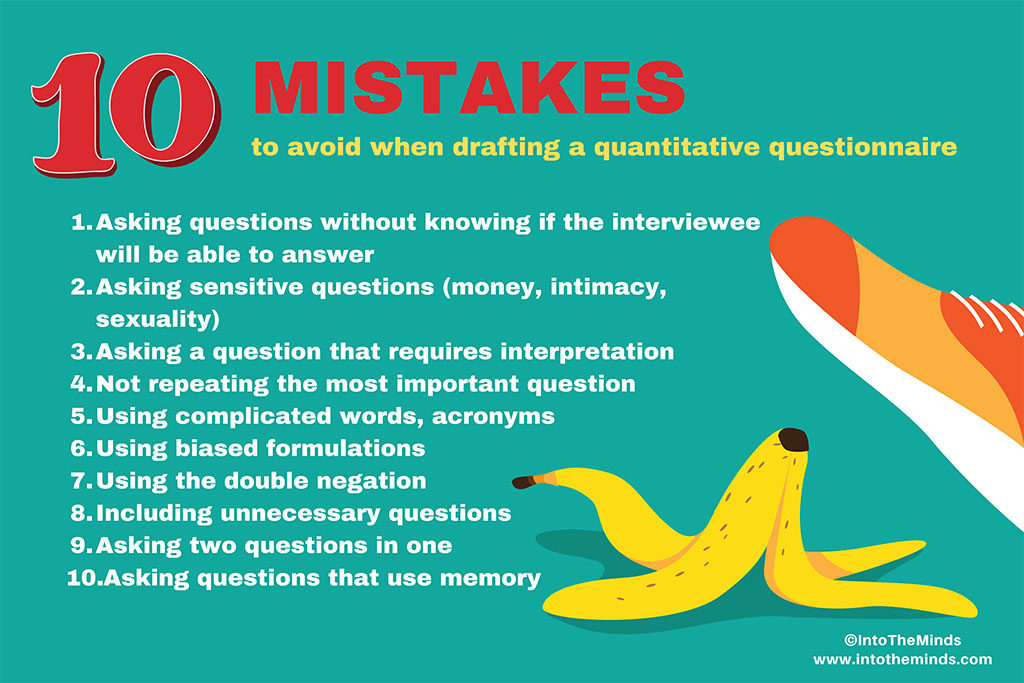
Writing a quantitative questionnaire, doing an online survey; all this has become very simple in the age of the Internet. Too simple, no doubt, because errors appear at the very moment of writing the quantitative questionnaire.
[call-to-action-read id=”35845″]
We have listed for you the 10 mistakes that you should avoid when writing the questions of a quantitative questionnaire
- Using complicated words, acronyms
- Using biased formulations
- Using the double negation
- Including unnecessary questions
- Asking questions without knowing if the interviewee will be able to answer
- Asking sensitive questions (money, intimacy, sexuality)
- Asking two questions in one
- Asking a question that requires interpretation
- Asking questions that use memory
- Not repeating the most important question
The golden rule is to ensure that you stay below the 20 questions and 10-minute answer time. With this limitation set, what rules should you follow to draft the questions in your online survey effectively?

credits: Shutterstock
1. Using complicated words
Technical words, valuable formulations and acronyms should be avoided. They cause additional comprehension difficulties for respondents that you can avoid. Find simple formulations, and your questionnaire will be made more accessible, its administration will be faster, and the results will be of better quality.
2. Using biased formulations
Some formulations may “direct” the respondent’s response (also called “biased”). It is, therefore, necessary to remain neutral, an exercise that is not always easy.
Here are some formulations to be absolutely avoided:
- “don’t you think that…”
- “it’s good, isn’t it?”
- “would you say you are…”
3. Using the double negation
As a logical follow-up to the previous point, the double negation is a convoluted formulation that complicates the understanding of the issue and can only cause problems. Avoid it at all costs!
Some examples of double negation in the context of a quantitative questionnaire:
- “aren’t you planning on not buying a car this year?”
- “in your opinion, is the use of glyphosate not safe?”
To further explore this theme, we recommend this entertaining reading on the Le Figaro website.
4. Including unnecessary questions
Is the question you are about to ask strictly necessary? Remember that you only have 10 minutes, and only the questions that are relevant to your project should be asked. This is particularly true for questions (to be reserved at the end of the questionnaire as they require the least time to consider) about the respondent’s identity. It is not necessary to ask him/her the number of dependent children and income level if these factors are not relevant to your study.
5. Asking questions without knowing if the interviewee will be able to answer
Often only one questionnaire is required. But when you target several customer categories, you have to ask yourself what makes them different and in particular, if all the questions are adapted to all the groups. There is nothing worse than asking a question to which the respondent cannot give an answer. Consider using conditional connections to differentiate between different customer categories.

6. Asking sensitive questions (money, intimacy, sexuality)
Some questions will only get biased answers. This is the case with so-called “sensitive” issues that concern money, sexuality and the intimacy of the person.
Here are some obvious examples and others that are less so:
- Do you have a safety deposit at home?
- Do you read erotic magazines?
- Are you happy with your partner?
If the answers to these questions are crucial to your market research, you will need to use less intrusive wording and use several questions to get as close to the truth as possible.
7. Asking two questions in one
Aiming for brevity in an online survey or any other quantitative questionnaire is a laudable goal. But if you want to compact everything, you could inadvertently ask two questions in one… and of course, get only one answer. To recognise the danger, it is sufficient to identify the presence of the word “or”. “Do you think that x or y” will require a yes or no answer without you knowing if it refers to x or y.
8. Asking a question that requires interpretation
This pitfall of quantitative questionnaires is not easy to avoid. An example is better than a long speech, so be sure to observe the following two questions:
- “Have you been to the movies recently?”
- “How much gasoline do you use on average?”
Words or expressions in bold are subject to interpretation (which may be perfectly acceptable if you use a subjective scale, that is to say if your objective is to measure perceptions rather than tangible facts.
To return to our examples, “recently” can have a completely different meaning depending on the amount of free time you have. If you are a student “recent” will probably mean “last week”. If you are a young parent, “recently” can be read as “in the last 6 months”.
For the second question, the problem is the same. Are you talking about an average in litres per 100 km, in litres per month, in Euros per month? If all these answers are perfectly valid, you may discover at the end of your survey that they are unusable.
9. Asking questions that use memory
“How many yoghurts did you buy last year?”; “What were you doing last year at the same time?” These formulations are, of course, extreme and unlikely, but they will still serve to illustrate our point.
Using memory is a source of bias because memory is fallible, especially in the long term. We, therefore, advise you to limit this type of question as much as possible and to recontextualise it.
10. Not repeating the most important question
Sometimes your survey will be structured around a central question. If this is the case, think about doubling it at the beginning and at the middle or end of the questionnaire to ensure that the respondents’ understanding and the consistency of their answers are correct. However, be careful to vary the wording so as not to irritate the respondents (who wants to answer the same thing twice?).
If you have any questions or would like to submit your online survey or quantitative survey project to us, simply contact us.
Credit: shutterstock
Posted in Marketing.

